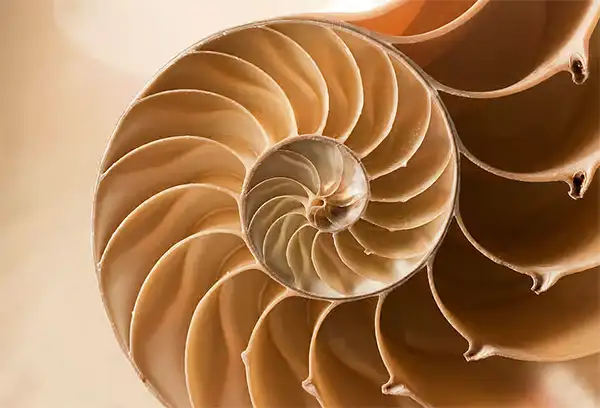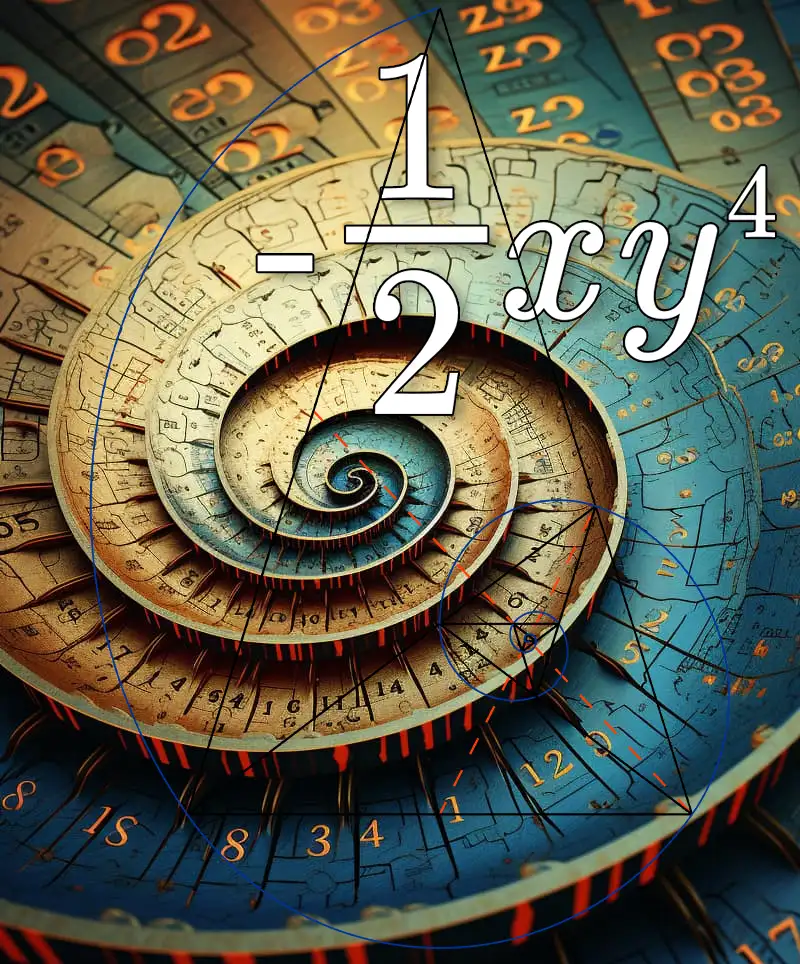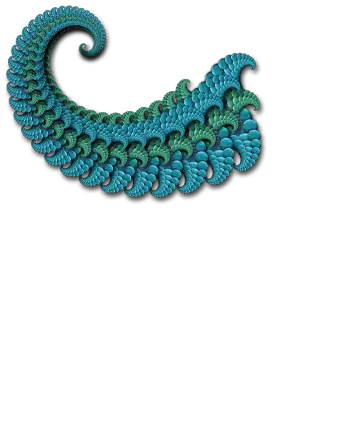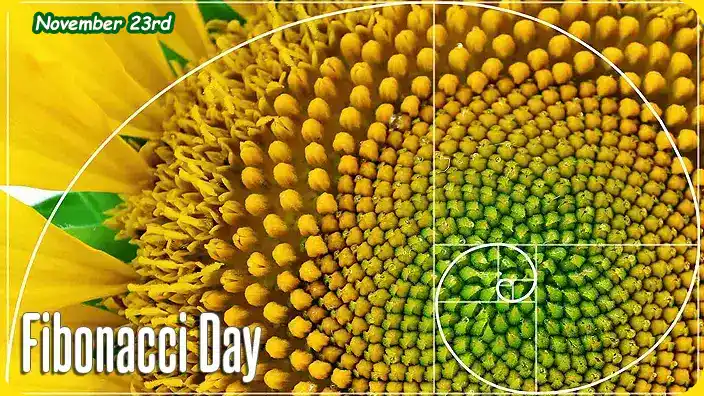Whirling into the World of Fibonacci
Attention all number enthusiasts and nature lovers! Fasten your seatbelts and put on your thinking caps because we're about to embark on a fantastical journey into the enchanting and whimsical world of Fibonacci Day! Celebrated each year on November 23rd, this date (11/23) cleverly mirrors the beginning of the famous Fibonacci Sequence (1, 1, 2, 3...), serving as a playful nod to these influential numbers. But hold on, there's more! Fibonacci Day isn't just a day for math geeks to unite; it's an all-encompassing festival where mathematics, the beauty of the natural world, and a sense of humor intertwine in an extraordinary dance.
This special day celebrates the Fibonacci Sequence, a series where each number is the sum of the two preceding ones. But it's not just about cold, hard numbers. It’s a day to marvel at how these numbers reveal themselves in the most unexpected places - from the spirals of a sunflower to the swirls of a galaxy. It's about discovering the secret patterns that govern our world, from tiny shells on the beach to the vastness of space.
So, whether you're a hardcore number cruncher or just someone who appreciates the little wonders of the world, Fibonacci Day promises to be a delightful adventure. It's a chance to see the universe through a different lens – where mathematics is not just equations on a chalkboard but a living, breathing presence in everything around us. Prepare to be amazed, tickled, and enlightened as we dive headfirst into Fibonacci's captivating, spiral-filled world!
The Man Behind the Magic
As we celebrate Fibonacci Day, it's only fitting to shine the spotlight on the show's star: Leonardo of Pisa, better known as Fibonacci. Born around 1170 in medieval Italy, Fibonacci was no ordinary mathematician. His curiosity and intellect led him to become one of the most influential figures in the history of mathematics.
 Fibonacci's journey into the world of numbers was as adventurous as it was intellectual. As a young man, he traveled extensively with his father, a Pisan trading merchant. These journeys across the Mediterranean weren't just about trade; they were a gateway to the mathematical and cultural knowledge of the Arab world. Here, Fibonacci first encountered the Hindu-Arabic numeral system, a system that used digits 0-9 and place value – a revolutionary concept at the time.
Fibonacci's journey into the world of numbers was as adventurous as it was intellectual. As a young man, he traveled extensively with his father, a Pisan trading merchant. These journeys across the Mediterranean weren't just about trade; they were a gateway to the mathematical and cultural knowledge of the Arab world. Here, Fibonacci first encountered the Hindu-Arabic numeral system, a system that used digits 0-9 and place value – a revolutionary concept at the time.
Seeing the immense potential of this system, Fibonacci became its most enthusiastic ambassador in the West. In 1202, he published "Liber Abaci" (The Book of Calculation), a groundbreaking work that introduced Europe to these Arabic numerals and explained their use in arithmetic operations. But Fibonacci's influence didn't stop at revolutionizing numerical notation. His book also presented practical problems related to commerce and daily life, showcasing the real-world applications of mathematics.
However, Fibonacci's most enduring legacy is, without a doubt, the sequence that bears his name. Although he didn't discover it (it was known in India long before), he brought it to the Western world's attention by using it to solve a rabbit breeding problem in "Liber Abaci." Little did he know that this sequence would become a recurring pattern in nature, observed in the arrangement of leaves on a stem, the fruitlets of a pineapple, the flowering of artichokes, and the spirals of shells.
In essence, Leonardo of Pisa was more than just a mathematician; he was a visionary who bridged different worlds through his love of numbers. His insights and teachings laid the foundation for modern mathematics, inspiring fascination and wonder in mathematicians and laypeople alike. On Fibonacci Day, we don't just celebrate a sequence of numbers; we pay homage to a man whose legacy reminds us of the beautiful symphony between mathematics, nature, and human discovery.
The Sequence
Let's break down the Fibonacci Sequence in a way that's as easy as pie. The beauty of this sequence lies in its simplicity and the way it builds upon itself.
Imagine you're starting with two very small numbers: 0 and 1. These are the seeds from which the entire sequence grows. Here's how it works:
- Start with 0 and 1: These are the first two numbers in the sequence. Easy, right?
- Add the Last Two Numbers to Get the Next One: Now, take those two numbers (0 and 1) and add them together. 0 plus 1 equals 1. So, the next number in the sequence is another 1.
- Keep Adding: Now, move one step forward. Take the last two numbers you've used (1 and 1) and add them together. 1 plus 1 equals 2. So, 2 is the next number in the sequence.
- Continue the Pattern: You just keep going like this. After 2, you add 1 (the last number) and 2 (the one before that) to get 3. Then, add 2 and 3 to get 5. Keep the pattern going: 3 and 5 make 8, 5 and 8 make 13, and so on.
So, the sequence starts like this: 0, 1, 1, 2, 3, 5, 8, 13, 21, 34...
To visualize it, think of it as a simple addition ladder. You're always climbing up by using the last two rungs (numbers) you stepped on to find the next rung. This pattern continues infinitely, creating a series of numbers that may look random at first glance but are actually the result of a very straightforward and repetitive process.
And the cool part? This sequence, which starts with something as simple as 0 and 1, pops up in the most unexpected places in nature, art, and architecture. It's like a secret code hidden in plain sight, waiting to be discovered. That's the magic of the Fibonacci Sequence - a cosmic conga line of numbers dancing through the universe!
Nature's Got the Beat
It's fascinating how the Fibonacci Sequence, something that seems purely mathematical, shows up in the grand canvas of nature. It's like uncovering a secret rhythm or pattern that Mother Nature uses as her blueprint. Let's explore some of these natural wonders where the Fibonacci Sequence makes a star appearance.
- Flower Petals: Many flowers are not just randomly put together. They often have a number of petals that is a Fibonacci number. For instance, lilies typically have three petals, buttercups have five, chicory has 21, and daisies can have 34, 55, or even 89 petals. This isn't a coincidence but a pattern that repeats across various species.
- Pinecones and Pineapples: Ever looked closely at a pinecone or pineapple? The scales of a pinecone or the diamond-shaped sections of a pineapple are arranged in a spiral pattern. If you count these spirals, you'll find they often come in Fibonacci numbers. This pattern allows for the most efficient packing of seeds in a pinecone or the most compact growth of a pineapple's skin.
- Spiral Galaxies: The universe itself seems to be a fan of Fibonacci. Spiral galaxies, like our Milky Way, often exhibit a spiral pattern that can be described by Fibonacci numbers. These sprawling cosmic structures spread out in swirling patterns that resemble the same type of spirals found in sunflowers or pinecones.
- Shells and Snails: The nautilus shell is perhaps the most iconic example of the Fibonacci Sequence in nature. As it grows, the shell spirals outwards, and each new chamber is proportionally larger than the last in a way that mirrors the Fibonacci Sequence.
- Tree Branching: Even the way trees branch out is influenced by this sequence. The branching pattern often follows the Fibonacci numbers, with a single trunk splitting into two branches, which then split into three, then five, and so on. This pattern allows for the optimal exposure of leaves to sunlight.
- Hurricanes and Whirlpools: Even some of the most powerful phenomena in nature follow this pattern. The arms of hurricanes often spiral outwards, resembling the Fibonacci spiral. This is also seen in smaller whirlpools and even in the way water drains from your bathtub.
In each of these cases, the Fibonacci Sequence provides a solution to an optimization problem. In flowers and pinecones, it's about the most efficient way to pack seeds or petals. In galaxies, it's about the distribution of mass and angular momentum.
By observing these patterns, we get a glimpse into the underlying mathematical principles that govern our natural world. It's as if nature has been using mathematics as a language to write its most beautiful poems, with the Fibonacci Sequence being one of its favorite verses.

Art, Architecture, and Rabbit Populations
The Fibonacci Sequence, a simple yet profound mathematical pattern, has left its indelible mark not only in the fields of art and architecture but also in the natural phenomenon of rabbit populations. This sequence, which starts with 0 and 1, with each subsequent number being the sum of the previous two, reveals a surprising connection between these diverse realms.
In the World of Art: Artists throughout history have been fascinated by the proportions and aesthetics offered by the Fibonacci Sequence. This sequence is often associated with the Golden Ratio, which is approximately 1.618, a number many artists and architects have used to achieve balance and beauty in their work.
One of the most famous examples is Leonardo da Vinci's "Mona Lisa." It's believed that Da Vinci applied the Golden Ratio to define the proportions of the painting, resulting in a composition that is both pleasing to the eye and subtly complex. Similarly, the sequence's influence is speculated in other works of art, where the placement of key elements aligns with the ratios derived from the Fibonacci Sequence, creating a natural sense of balance and harmony.
In the Realm of Architecture: The Fibonacci Sequence and the Golden Ratio have also been guiding principles in architecture. The Parthenon in Athens is a classic example where these mathematical concepts come into play. The dimensions of this ancient temple are said to have been designed to embody the Golden Ratio, making it aesthetically pleasing and symbolically powerful.
Modern architects, too, have embraced the Fibonacci Sequence, using it to create spaces that feel organic and in harmony with human proportions and natural patterns. The influence of Fibonacci can be subtly observed from the layout of buildings to the design of individual elements like staircases and windows.
Rabbit Populations: A Natural Illustration: The rabbit problem, posed by Fibonacci himself, is a delightful illustration of how his sequence naturally appears in biological systems. Here, Fibonacci imagined a scenario where rabbits breed according to a specific set of rules, resulting in a population that grows in accordance with his sequence.
In this hypothetical problem, a pair of rabbits start reproducing after a month, and every month thereafter, each pair produces a new pair, which also starts reproducing from their second month. As this pattern continues, the number of rabbit pairs at the end of each month represents a Fibonacci number: 1, 1, 2, 3, 5, 8, 13, 21, and so on. This model, though simplified, highlights the sequence's relevance in understanding population growth and dynamics, an area of study crucial in biology and ecology.
Connecting Dots Across Disciplines
The presence of the Fibonacci Sequence in art, architecture, and natural phenomena like rabbit populations underscores a fascinating aspect of our world: the interconnectedness of different fields through shared patterns and principles. It shows us how a mathematical sequence can manifest in creative human endeavors and the natural world, creating a bridge between the abstract and the concrete, the artistic and the scientific.
Celebrating the Fibonacci Sequence in these varied contexts is an acknowledgment of its mathematical elegance and a recognition of the universal patterns that bind together different aspects of our experience, from the paintings we admire to the buildings we inhabit and even to the natural processes we observe.
So why throw a party for a bunch of numbers? Because they're everywhere! Fibonacci Day is a reminder of the harmony between math, nature, and art. It's a day to marvel at the universe's hidden patterns and maybe even discover some new ones, like in your morning latte or your dog's curly tail.
Tips for a Fab Fibonacci Day
- Create a Fibonacci Feast: Whip up a menu with a Fibonacci twist. Think pineapple (spiral pattern) and broccoli (each floret is a Fibonacci spiral).
- Spiral Art Attack: Grab your pencils and spirals! Create art inspired by this mesmerizing sequence.
- Nature Walks with a Twist: Go on a Fibonacci scavenger hunt in nature. Count petals, leaves, and seeds – the sequence is everywhere!
- Math Jokes Galore: Why was six afraid of seven? Because 7, 8 (ate), 13! Okay, math jokes may need a little work, but they're part of the charm.
So there you have it. Fibonacci Day isn't just about honoring a sequence of numbers; it's a celebration of the patterns that dance around us every day. Whether you're a math whiz or someone who still counts on fingers (no judgment here), take a moment to appreciate the beauty and humor in the world of numbers. Who knows, you might just find Fibonacci's sequence in the most unexpected places!
Please Share our Content






 Fibonacci's journey into the world of numbers was as adventurous as it was intellectual. As a young man, he traveled extensively with his father, a Pisan trading merchant. These journeys across the Mediterranean weren't just about trade; they were a gateway to the mathematical and cultural knowledge of the Arab world. Here, Fibonacci first encountered the Hindu-Arabic numeral system, a system that used digits 0-9 and place value – a revolutionary concept at the time.
Fibonacci's journey into the world of numbers was as adventurous as it was intellectual. As a young man, he traveled extensively with his father, a Pisan trading merchant. These journeys across the Mediterranean weren't just about trade; they were a gateway to the mathematical and cultural knowledge of the Arab world. Here, Fibonacci first encountered the Hindu-Arabic numeral system, a system that used digits 0-9 and place value – a revolutionary concept at the time.









 "Sláinte!" is a traditional Irish expression used as a toast, equivalent to "Cheers!" in English.
"Sláinte!" is a traditional Irish expression used as a toast, equivalent to "Cheers!" in English.